On this page you will find an overview of the materials we use at Vedder & Vedder. We explain per material what the characteristics and properties are, so you know exactly what your jewelry is made of. Curious about how you can best care for your jewelry, check out our tips for care here.
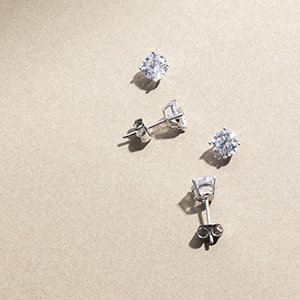
925 Sterling Silver
Silver is a timeless white precious metal with a unique luster. We use silver with a grade of 925/1000, also called sterling silver or first grade silver. Pure silver or fine silver is not suitable for making jewelry, which is why it is mixed with copper or other metals. So your silver jewelry always contains a little bit of another metal. Although silver belongs to the precious metals, silver has the nasty property of oxidizing when it comes into contact with hydrogen sulfide. The silver then turns black and dull. Hydrogen sulfide is a gas that is found not only everywhere in the air but also in wool, latex or perfume, for example. So be extra careful with these products near your precious jewelry!

Gold-plated Silver
Gold-plated silver has the luxurious look of gold, but is more friendly in price. With gold-plated silver, the base of the jewelry is silver. Over this, a thin gold layer (between 3 and 5 microns) is applied. The gold layer on gold-plated jewelry is thin and therefore susceptible to wear. Gold-plated jewelry will retain its color and shine the longest if you care for it according to our Jewelry Care Guide.
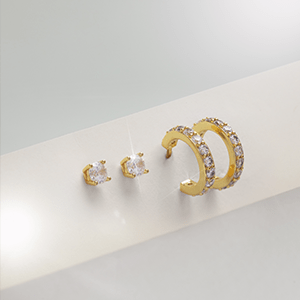
Gold-plated Brass
In a piece of gilded brass jewelry, the substrate is brass, a gold-colored metal. A thin layer of rhodium is applied over it. This white metal keeps the brass from oxidizing. As a top layer, there is a gold layer over it. Wear and tear can expose the underlying layers.
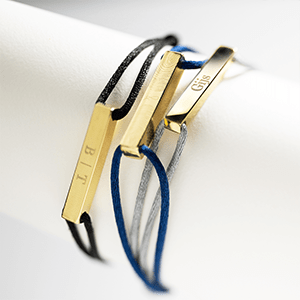
Gold-plated steel
The base is steel. A thin gold layer is then applied over this. The thickness of this layer is between 2 and 5 microns.

Steel
For our steel jewelry, we use stainless steel, also known as stainless steel or stainless steel. Steel jewelry has a dark silver-gray color and high scratch resistance. The dark gray color gives steel jewelry a rugged look, which makes it perfect for men's jewelry. Because of its high scratch resistance, you will also see steel a lot in our kids collection.
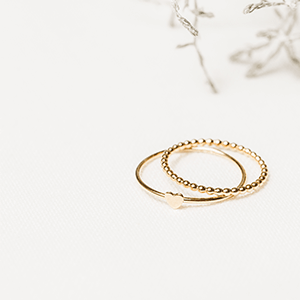
Goldfilled
Goldfilled jewelry has a brass base. Through a process of heat and pressure, a gold layer is bonded to this. The gold layer is thicker than gold-plated jewelry and because the brass base is gold colored, the jewelry will not discolor to silver when worn.

Rhodium-plated Silver
A rhodium-plated silver jewelry piece is a silver jewelry piece coated with a thin layer of rhodium. Rhodium is a white-colored precious metal. In addition to its bright white color, rhodium gives the silver an extra layer of protection against scratches and oxidation.
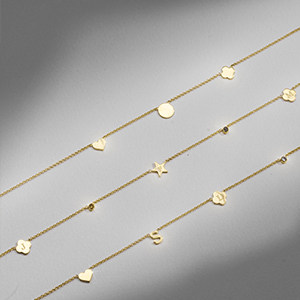
Solid 9K
9K jewelry, also referred to as 375, contains 37.5% pure gold and 62.5% other metals such as silver, copper or palladium. Because 9K jewelry contains a lower gold content than 14K gold jewelry, they are more attractively priced and a good alternative to our 14K gold line. A 9K piece of jewelry will not discolor easily. Note, however, that due to the high addition of other metals, 9K will discolor faster than 14K gold. Also, a reaction of the wearer with the other metals, for example copper or silver, will occur faster because they are present in higher amounts.
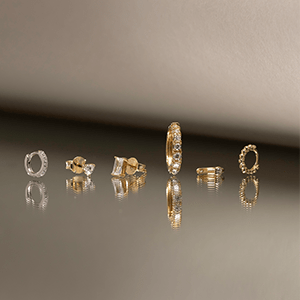
Solid 14K Gold
14K gold jewelry, also referred to as 585, contains 58.5% pure gold and 41.5% other metals such as silver, copper or palladium. These other metals are added to make the gold stronger and more durable. Gold is a precious metal, meaning it does not easily react with other substances such as oxygen and acids. Because of this, gold will not discolor easily and gold jewelry retains its luster for a long time.

Cubic Zirconia
Cubic Zirconia is a synthetic gemstone very similar to diamonds. Although zirconias do not have the durability and rarity of real gemstones, they do have a similar luster, clarity and are available in all colors. In addition, they are more attractive in price.
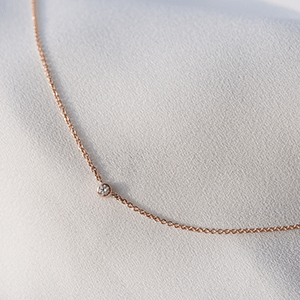
Labdiamond
A labdiamond, also called a lab grown diamond, is a diamond that is identical in composition to a natural diamond, but is created in a laboratory rather than in the earth. It has the same brilliance, hardness and chemical composition as a natural diamond. The manufacturing process of labdiamonds is more sustainable (no damage to the environment or human rights) than mining from mines. In short, you get the quality of a diamond, at a lower price and with a clearer conscience.
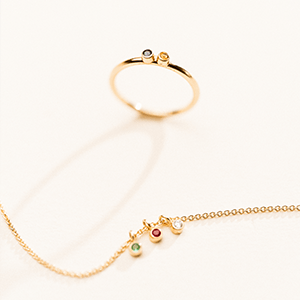
Gemstone
Gemstones are natural minerals and rocks. We work for our birthstone jewelry with: garnet, amethyst, topaz, (lab) diamonds, emerald, black spinel, ruby, peridot, sapphire, pink tourmaline, citrine and tanzanite. Because gemstones are natural products and are cut by hand, they can vary in color, luster and shape. This natural variation makes each stone unique.
